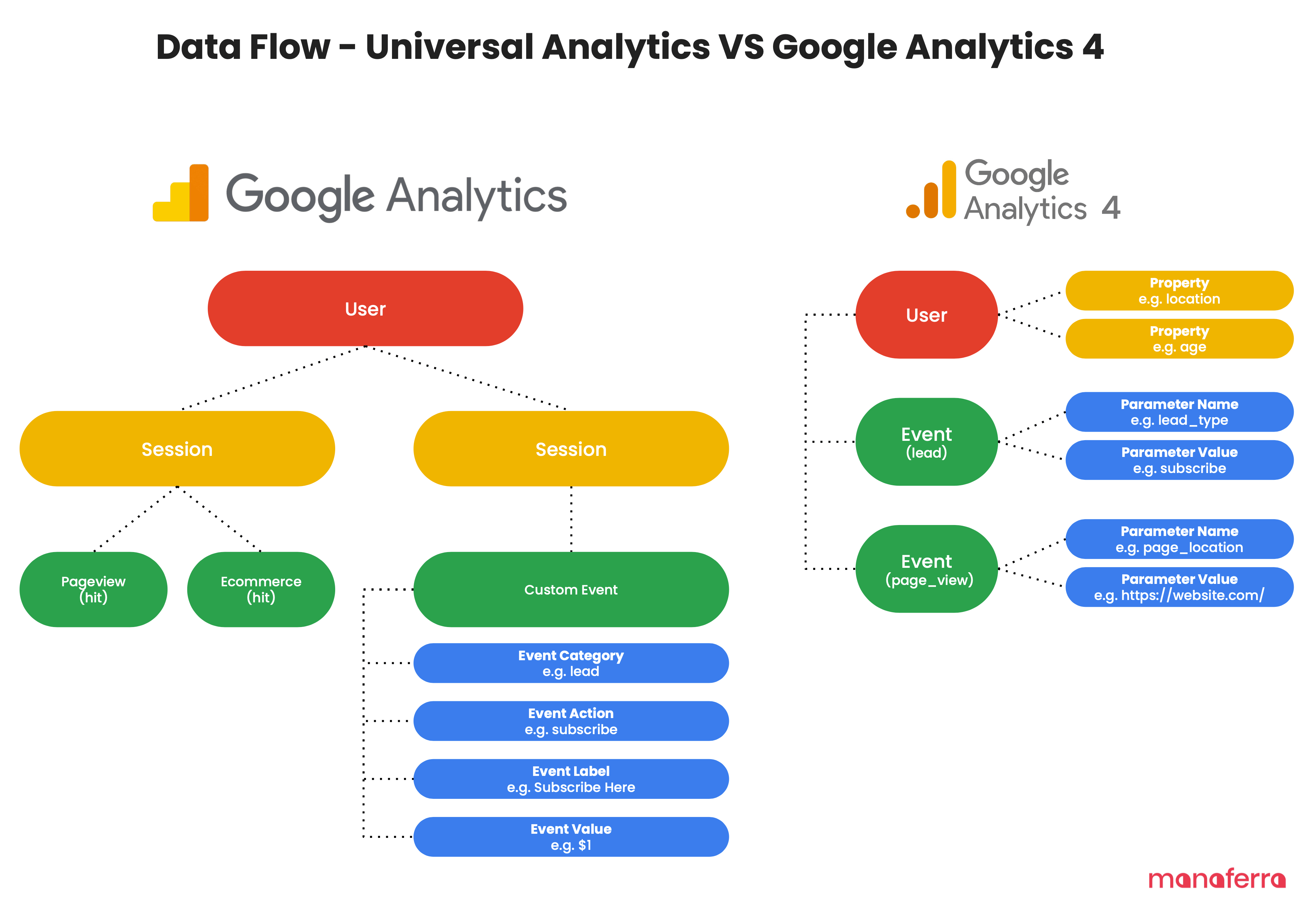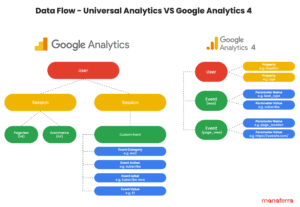Google Analytics 4 (GA4) stands as a valuable web analytics service within the Google Marketing Platform, serving a diverse audience, including website owners, marketers, and organizations.
Its significance lies in aiding small to medium-sized businesses in collecting and leveraging user behavior data for enhanced marketing, increased web traffic, and improved user retention strategies.
If you identify yourself in any of the mentioned roles, you might want to read on. By the end of this article, you will get to know –
- What is Google Analytics 4
- What it does
- How GA4 works
- What are the new features
- What are the pros and cons
Table of Contents
ToggleWHAT IS GOOGLE ANALYTICS 4?
GA4 is a pivotal tool for gathering data-driven insights into online businesses. It offers:
- Insights into user behavior.
- Tracking of website performance.
- Optimization of marketing strategies.
- All this can be accessed with a simple Google account.
WHAT DOES GOOGLE ANALYTICS DO?
GA4 adopts an innovative approach by amalgamating data from websites and apps, offering a more comprehensive customer understanding. Unlike its predecessor, Google Analytics 3, GA4 relies on event-centered data, introducing privacy features like cookieless measurement and behavioral and conversion modeling.
It simplifies complex data models, facilitating integration with media platforms, and enabling thorough analysis of critical customer usage metrics.
- It comes with privacy features like-
- Cookieless measurement
- Behavioral and conversion modeling
HOW GA4 WORKS EXACTLY?
GA4 leverages the power of AI and machine learning to track the path of customers across various platforms and provide useful insights about user behavior and interaction.
Leveraging AI and machine learning, GA4 tracks customer journeys across platforms, collecting user behavior insights. It uses small JavaScript “tags” on webpages, gathering data from users’ interactions.
This data is then sent to Google’s servers and used to generate customizable reports, summarizing key metrics chosen by the website owner.
WHAT ARE THE NEW FEATURES IN GA4?
If we come down to the bottom line of all this, one must ask the question if it is worth it to switch to GA4.
GA4 is different from GA3, also known as Universal analytics in various aspects, the key difference being the data model. As mentioned, GA3 derived insights based on sessions while GA4 is event-based.
GA4 differs significantly from Universal Analytics (GA3) in data modeling and presents several new features:
- A new dashboard. The navigation bar includes buttons for home, reports, explore, advertising, configure, and library.
- Addition of machine learning and AI tools
- A deeper connection of Google Analytics with Google Ads makes data-driven optimization of marketing data much easier.
- Codeless tracking features with lower latency allow data collection sans the manual addition of tracking codes into every part of a website.
- Reporting is customer-centric and designed around lifecycle data. This helps us learn about user experience from start to end.
- Enhancement in Data control features for regulatory compliance and data management, making it easier for website owners to handle user data in compliance with data privacy rules.
- It offers a completely new interface. Instead of relying on third-party cookies, this version relies on machine learning models for increased accuracy.
- While page views were the most important metric in Universal analytics, the new GA4 measures events. It measures metrics such as Users, Pageviews, Purchases, Sessions, Session/Traffic Acquisition metrics, Conversions, Bounce rate, and Event count.
COMPARING THE PROS AND CONS OF GOOGLE ANALYTICS 4
While the added features are certainly very comprehensive in GA4, let’s delve deeper and weigh the pros and cons fully.
The pros-
- It helps us track the user from start to end and shows how a customer moves through a website.
- It gives a better overview of user engagement and user interaction.
- It helps us build a stronger target audience for advertising campaigns
- In compliance with regulations regarding user privacy and data.
- Enables better goal setting.
- Enhancement in the visual representation of data.
- Data is reported better.
- Cross-platform tracking- Data is tracked from both the web and app in one property.
The cons-
- The new platform might be difficult to understand as the interface is different from what the users are used to
- It is unclear where the data is stored.
- Everything is categorized as “event” as GA4 does not use hit types.
- There is a limit on the number of custom dimensions that can be used.
- Consent might be required for marketing practices in the future
- GA4 does not allow custom channel groupings
So what’s the final takeaway about GA 4 aka the Google Analytics 4?
GA4 represents a relatively big paradigm shift, designed to accommodate the modern multi-device web user. While Universal Analytics served its purpose, the shift towards diverse device usage necessitates GA4’s cross-platform tracking to provide insights into how users access the internet across different devices.





